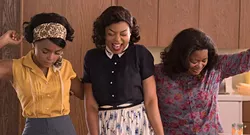
Once upon a time—during the early years of America's space program—"computer" meant "person who does manual calculations." This was considered rather menial labor, particularly when a woman did it—and lots of women did it. Though they were as smart and as educated—and often did much of the same work—they were paid less in money and in respect than their male counterparts (who held titles such as "engineer"). Anything done by black women was, obviously, barely worth mentioning.
And barely mentioned at all has, outrageously, been the fate of so many black women who were essential to the U.S. space program of the 1960s. You know Alan Shepard (first American in space) and John Glenn (first American to orbit Earth). But you have probably never heard of Katherine Johnson, Dorothy Vaughn and Mary Jackson—who were pioneers in, respectively, mathematics, computer programming and engineering at NASA—without whom those guys never would have flown.
Hidden Figures is an about-damn-time true story that smashes the notion that the only people who had the Right Stuff in the moon-shot effort were white and male. This is no dry history lesson, though, but an often funny, ultimately feel-good triumph of geeks who faced even more absurd obstacles than any white boy with a pocket protector. It's disgraceful that it has taken this long for its like to come along. Now that it's here, Hidden Figures is cause for celebration.
Empire's Taraji P. Henson is completely marvelous as Johnson, who does a lot of standing at blackboards chalking out calculations and making that process genuinely thrilling, not only because—geeky squee—she is trying to invent the math needed to put a ship into orbit and return it safely to Earth. She lets us feel the gears turning in her head, and we share how transporting it is for her to escape into numbers when so much of her day is spent merely convincing the white men around her that she can do the job. Director Theodore Melfi (St. Vincent) wrings a lot of wry humor out of simple visual moments, such as when Johnson hesitates while typing a report for reasons that have everything to do with her agitating for validation. Melfi also makes sly visual allusions to iconic moments from The Right Stuff: Johnson does a lot of running around NASA's Langley, Va., campus à la Jeff Goldblum in the 1983 film, though for wildly different reasons.
Melfi's use of the "victory walk," which The Right Stuff director Philip Kaufman all but invented, has the always-wonderful Octavia Spencer as Vaughn leading her "colored computers" to a plum new assignment at NASA that she has made possible. It's clearly meant to elevate these women (and rightly so) to a realm as rarefied as the one the Mercury 7 astronauts have enjoyed, thanks in part to Kaufman's visual iconography. Melfi might be the first filmmaker to have truly recaptured the power of those images, with characters who have actually earned the right to be proud of their achievements. It's a glorious moment in the film.
Then there's Jackson, whom Janelle Monáe makes the spikiest of the three as she faces an actual legal battle to get into NASA's engineering training program. And so Hidden Figures makes up for another omission of cinema: We've barely seen onscreen the realities of day-to-day workplace life under segregation, a shameful period of the nation's history that demands much more examination in pop culture. Here, through the interconnected stories of all three women, we feel the weight of the the ignominy of separate public facilities and the pressure to not complain about it, lest one be tagged as a troublemaker. Johnson does finally snap in a scene that is devastating.
Some white folks do get woke over the course of the narrative, but they are not the focus of the story; they are merely listening to the voices and experiences of black women being heard, really heard, at long last. And therein lies the beauty of Hidden Figures. This shouldn't be a rarity. It's a hugely entertaining movie, but it's also an important and necessary one.